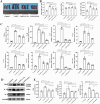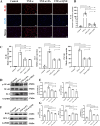Ferulic acid suppresses the inflammation and apoptosis in Kawasaki disease through activating the AMPK/mTOR/NF-κB pathway
- PMID: 39268468
- PMCID: PMC11390509
- DOI: 10.3389/fphar.2024.1420602
Ferulic acid suppresses the inflammation and apoptosis in Kawasaki disease through activating the AMPK/mTOR/NF-κB pathway
Abstract
Background: Kawasaki disease (KD) is a self-limiting and acute systemic vasculitis of unknown etiology, mainly affecting children. Ferulic acid (FA), a natural phenolic substance, has multiple pharmacological properties, including anti-inflammatory, anti-apoptosis, and anti-fibrosis, and so on. So far, the protective effects of FA on KD have not been explored.
Methods: In this study, we established Candida albicans water soluble fraction (CAWS)-induced mouse coronary artery vasculitis of KD model and the tumor necrosis factor α (TNF-α)-induced human umbilical vein endothelial cells (HUVECs) injury model to investigate the anti-inflammatory and anti-apoptosis effects of FA on KD, and try to elucidate the underlying mechanism.
Results: Our in vivo results demonstrated that FA exerted anti-inflammatory effects on KD by inhibiting the infiltration of CD45-positive leukocytes and fibrosis around the coronary artery. Additionally, FA downregulated the levels of inflammatory and chemotactic cytokines, alleviated splenomegaly, and exhibited anti-apoptotic effects on KD by reducing TUNEL-positive cells, downregulating BAX expression, and upregulating BCL-2 expression. In addition, Our in vitro findings showed that FA could effectively inhibit TNF-α-induced HUVEC inflammation like NF-κB inhibitor QNZ by downregulating the expression of pro-inflammatory cytokines as well as attenuated TNF-α-induced HUVEC apoptosis by reducing apoptotic cell numbers and the BAX/BCL-2 ratio, which could be reversed by the AMPK inhibitor compound c (CC). The further mechanistic study demonstrated that FA could restrain vascular endothelial cell inflammation and apoptosis in KD through activating the AMPK/mTOR/NF-κB pathway. However, FA alone is hard to completely restore KD into normal condition.
Conclusion: In conclusion, FA has potential protective effects on KD, suggesting its promising role as an adjuvant for KD therapy in the future.
Keywords: apoptosis; coronary artery; ferulic acid (FA); inflammation; kawasaki disease (KD); vasculitis.
Copyright © 2024 Wu, Wang, Tan, Ran, Guan, Qian, Feng, Jiang, Peng, Sheng, Xi, Ji and Guo.
Conflict of interest statement
The authors declare that the research was conducted in the absence of any commercial or financial relationships that could be construed as a potential conflict of interest.
Figures









Similar articles
-
Hesperidin alleviates endothelial cell inflammation and apoptosis of Kawasaki disease through inhibiting the TLR4/IĸBα/NF-ĸB pathway.Chem Biol Interact. 2025 Apr 25;411:111445. doi: 10.1016/j.cbi.2025.111445. Epub 2025 Feb 21. Chem Biol Interact. 2025. PMID: 39987982
-
The protective roles of liraglutide on Kawasaki disease via AMPK/mTOR/NF-κB pathway.Int Immunopharmacol. 2023 Apr;117:110028. doi: 10.1016/j.intimp.2023.110028. Epub 2023 Mar 17. Int Immunopharmacol. 2023. PMID: 36934674
-
Protective Roles of Xijiao Dihuang Tang on Coronary Artery Injury in Kawasaki Disease.Cardiovasc Drugs Ther. 2023 Apr;37(2):257-270. doi: 10.1007/s10557-021-07277-w. Epub 2021 Oct 19. Cardiovasc Drugs Ther. 2023. PMID: 34665368
-
Protective Effect of Ferulic Acid on Lipopolysaccharide-Induced BV2 Microglia Inflammation via AMPK/mTOR Signaling Pathway.Molecules. 2023 Apr 14;28(8):3482. doi: 10.3390/molecules28083482. Molecules. 2023. PMID: 37110714 Free PMC article.
-
Potential Therapeutic Efficacy of Ferulic Acid and Its Derivatives in the Management of Cancers: A Comprehensive Analysis With Mechanistic Insight.Int J Food Sci. 2025 May 30;2025:2256871. doi: 10.1155/ijfo/2256871. eCollection 2025. Int J Food Sci. 2025. PMID: 40487371 Free PMC article. Review.
Cited by
-
Ferulic Acid as an Anti-Inflammatory Agent: Insights into Molecular Mechanisms, Pharmacokinetics and Applications.Pharmaceuticals (Basel). 2025 Jun 18;18(6):912. doi: 10.3390/ph18060912. Pharmaceuticals (Basel). 2025. PMID: 40573306 Free PMC article. Review.
-
Proteomic insights into molecular alterations associated with Kawasaki disease in children.Ital J Pediatr. 2025 Feb 21;51(1):56. doi: 10.1186/s13052-025-01853-8. Ital J Pediatr. 2025. PMID: 39984993 Free PMC article.
References
-
- Ahmad A., Biersack B., Li Y., Kong D., Bao B., Schobert R., et al. (2013). Targeted regulation of PI3K/Akt/mTOR/NF-κB signaling by indole compounds and their derivatives: mechanistic details and biological implications for cancer therapy. Anticancer Agents Med. Chem. 13 (7), 1002–1013. 10.2174/18715206113139990078 - DOI - PMC - PubMed
LinkOut - more resources
Full Text Sources
Research Materials
Miscellaneous

